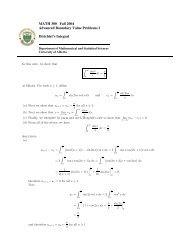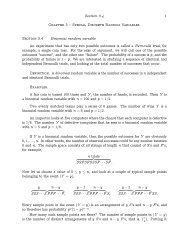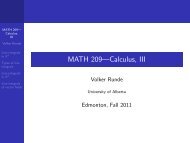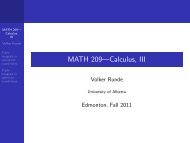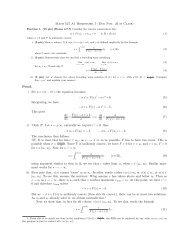118 CHAPTER 17. THE RIEMANN MAPPING THEOREM Condition (xi) makes no reference to holomorphic functions and is entirely topological in nature. It means that there is a bijective, continuous map f: D → D with a continuous inverse. Since (x) is preserved under homeomorphisms, we see that (xi) implies (x). For the converse, it is sufficient to show that C is homeomorphic to D (for D �= C, this is clear by Theorem 17.3). Since and C → D, z ↦→ z 1+|z| D → C, z ↦→ z 1−|z| are continuous and inverse to each other, this is indeed the case. The converse to Problem 11.1 states that the property (xii) for every holomorphic function f: D → C, there exists a sequence <strong>of</strong> polynomials converging to f compactly on D always holds for a simply connected domain. The pro<strong>of</strong> relies on Runge’s Approximation Theorem. There is also an equivalent condition for simple connectedness involving the extended complex plane C∞: (xiii) C∞ \D is connected.
Index C is a Field, 5 Biholomorphisms <strong>of</strong> D, 51 analytic, 28 analytic continuation, 105 angle preserving, 112 annulus, 57 Antiderivative Theorem, 27 Argument Principle, 90 Arzelà–Ascoli Theorem, 107 Bifurcation Theorem, 91 biholomorphic, 50 biholomorphically equivalent, 110 branch cut, 82 Casorati–Weierstraß Theorem, 55 Cauchy’s Integral Formula, 68 Cauchy’s Integral Formula for Circles, 35 Cauchy’s Integral Theorem, 70 Cauchy’s Integral Theorem for Annuli, 57 Cauchy’sIntegralTheoremforStar-Shaped Domains, 31 Cauchy–Hadamard formula, 16 Cauchy–Riemann Equations, 11 Cayley transform, 110 center, 30 closed, 24 Compact Convergence, 42 compact convergence, 43 complex conjugate, 6 complex differentiable, 9 complex numbers, 5 concatenation, 25 conformal, 50 ConformalityatNondegeneratePoints, 113 119 Conformality<strong>of</strong>BiholomorphicMaps, 113 connected, 24 contour integral, 23 cosine, 15 curve, 22, 27 deMoivre’s Theorem, 8 discrete, 87 endpoint, 22 endpoints, 22 entire, 40 equicontinuous, 107 Equivalence <strong>of</strong>HarmonicandMean-Value Properties, 102 essential, 55 exponential function, 15 extended complex numbers, 88 exterior, 66 Fractional Residue Theorem, 80 function element, 104 Fundamental Theorem <strong>of</strong> Algebra, 40, 92 Gamma Function, 81 Generalized Cauchy Integral Formula, 38 generalized Cauchy integral formula, 38 germ, 105 Goursat’s Lemma, 28 harmonic, 94 Harmonic Components, 94 harmonic conjugate, 95 Harmonic Conjugates, 95 Higher Derivatives, 38 Higher Derivatives <strong>of</strong> Power Series, 21 holomorphic, 28
- Page 1 and 2:
Math 411: Honours Complex Variables
- Page 3 and 4:
Contents 1 The Complex Numbers 5 2
- Page 5 and 6:
Chapter 1 The Complex Numbers Defin
- Page 7 and 8:
Proof. (i): If z = x+iy, then ¯z =
- Page 9 and 10:
Chapter 2 Complex Differentiation D
- Page 11 and 12:
(i) there exists c ∈ C such that
- Page 13 and 14:
Example. Let Then f is totally diff
- Page 15 and 16:
holds over C. We obtain: � ∞�
- Page 17 and 18:
Figure 3.2: Surface plot of cos(z)
- Page 19 and 20:
It follows that {an(z−z0) n } ∞
- Page 21 and 22:
Problem 3.1. Show in Theorem 3.2 th
- Page 23 and 24:
Definition. The length of a piecewi
- Page 25 and 26:
1. Given a < b < c and two curves
- Page 27 and 28:
That is, F ′ (z) = f(z). Theorem
- Page 29 and 30:
∆ (4) ∆ (1) ∆ (2) As the line
- Page 31 and 32:
Proof. Let z0 ∈ D be a center for
- Page 33 and 34:
four subtriangles, denoted by ∆(z
- Page 35 and 36:
γ1 Then it is clear that � � 1
- Page 37 and 38:
Proof. There is no loss of generali
- Page 39 and 40:
Proof. Apply Theorem 5.3 and 5.4. E
- Page 41 and 42:
is entire. Since p is a nonconstant
- Page 43 and 44:
(ii) for each compact K ⊂ D, the
- Page 45 and 46:
Proof. Let ζ ∈ ∂Br(z0), and no
- Page 47 and 48:
holds for some a0,a1,a2,... ∈ C a
- Page 49 and 50:
Proof. Let z0 ∈ D be such that |f
- Page 51 and 52:
Theorem 7.5 (Biholomorphisms of D).
- Page 53 and 54:
Define ⎧ ⎪⎨ g: D ∪{z0} →
- Page 55 and 56:
Define g: C → C, z ↦→ ∞�
- Page 57 and 58:
Chapter 9 Holomorphic Functions on
- Page 59 and 60:
It follows that � � f(ζ)dζ +
- Page 61 and 62:
Definition. The function h in Theor
- Page 63 and 64:
For the converse, let g: Br(z0) →
- Page 65 and 66:
Chapter 10 The Winding Number of a
- Page 67 and 68: Proposition 10.2 (Winding Numbers A
- Page 69 and 70: • if w �= z: � � |g(w,z)−
- Page 71 and 72: Corollary 11.2.1. Let D be an open,
- Page 73 and 74: Examples. 1. Let f(z) = eiz z 2 +1
- Page 75 and 76: 12.1. APPLICATIONS OF THE RESIDUE T
- Page 77 and 78: 12.1. APPLICATIONS OF THE RESIDUE T
- Page 79 and 80: 12.1. APPLICATIONS OF THE RESIDUE T
- Page 81 and 82: 12.2. THE GAMMA FUNCTION 81 12.2 Th
- Page 83 and 84: 12.2. THE GAMMA FUNCTION 83 Since
- Page 85 and 86: 12.2. THE GAMMA FUNCTION 85 6 5 4 3
- Page 87 and 88: Chapter 13 Function Theoretic Conse
- Page 89 and 90: Lemma 13.1. Let D ⊂ C be open and
- Page 91 and 92: Definition. Let D ⊂ C be open, an
- Page 93 and 94: Proof. Let p(z) = anz n +···+a1z
- Page 95 and 96: for (x,y) ∈ R 2 \{(0,0)}. The par
- Page 97 and 98: Proof. Of course, only (ii) =⇒ (i
- Page 99 and 100: so that u(z) = � 2π u(re 0 iθ )
- Page 101 and 102: Set K := supζ∈∂D|f(ζ)|. For z
- Page 103 and 104: Chapter 15 Analytic Continuation al
- Page 105 and 106: z0 ∈ D, the germ of f at z0—den
- Page 107 and 108: Chapter 16 Montel’s Theorem Defin
- Page 109 and 110: Define g: D → RM as follows: for
- Page 111 and 112: and note that z−i 1+ z+i g(f(z))
- Page 113 and 114: Example. Let z be a complex number.
- Page 115 and 116: By the Open Mapping Theorem, there
- Page 117: Proof. (i) =⇒ (ii) is Corollary 1
- Page 121: INDEX 121 straight line segment, 25



